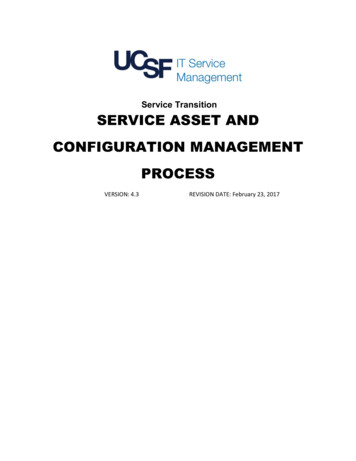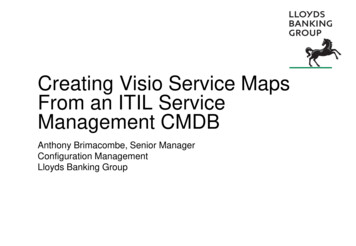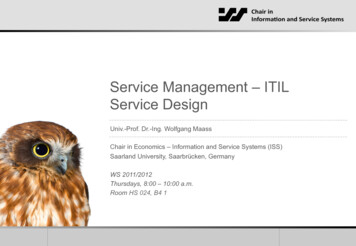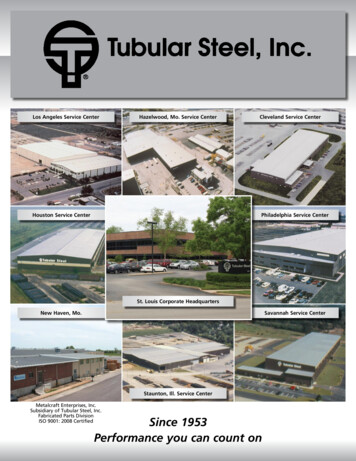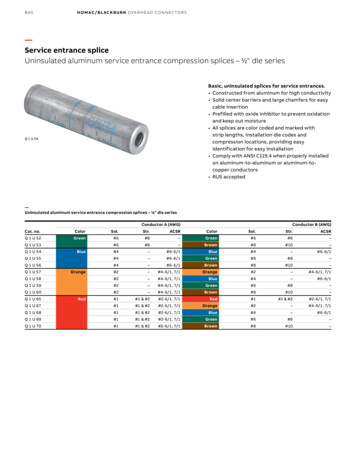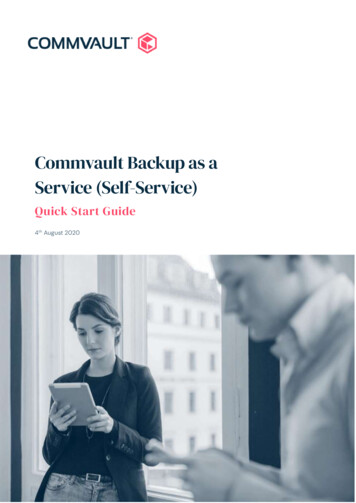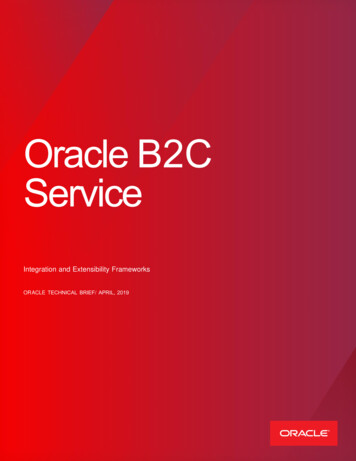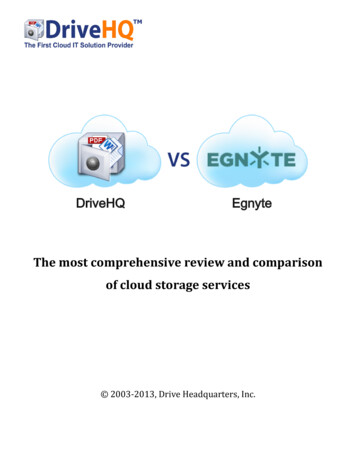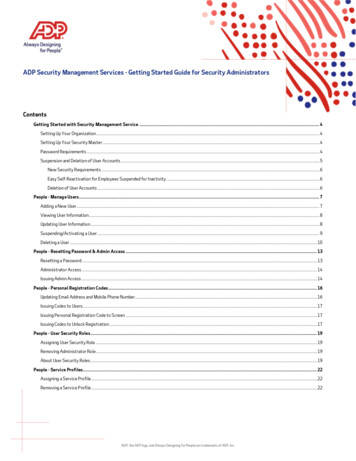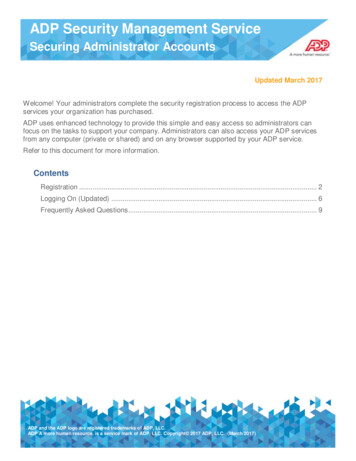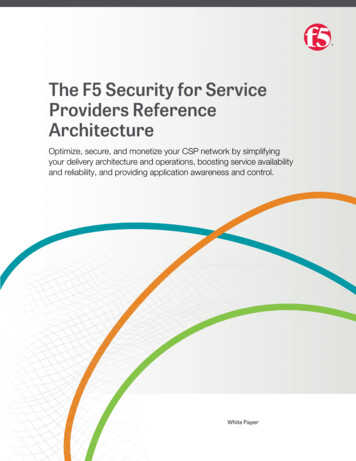
Transcription
The F5 Security for ServiceProviders ReferenceArchitectureOptimize, secure, and monetize your CSP network by simplifyingyour delivery architecture and operations, boosting service availabilityand reliability, and providing application awareness and control.White Paper
WHITE PAPER The F5 Security for Service Providers Reference ArchitectureIntroductionCommunications service providers (CSPs) must ensure that customers cansuccessfully make calls and use their smartphone apps with reliable connectivity,and provide differentiated services that enhance competitiveness and can boostrelatively flat revenue streams. Service providers therefore need to guaranteesuperior network quality without adding complexity or cost. Because securitythreats have a directly detrimental impact on network quality and customerexperiences, security is a top priority, and CSPs must constantly defend against agrowing number of threats.Meanwhile, service providers are grappling with explosive data growth whilecompetitive and industry pressures drive them to embark on time-consuming andcostly upgrades for 4G LTE. This transition is changing the security threatlandscape dramatically. In addition, IPv6 migrations and network functionsvirtualization (NFV) technology also are imminent or already underway. As a result,CSPs need multi-faceted support to ensure that their networks remain predictable,reliable, and available.F5 offers a suite of dynamic, multi-layered security solutions capable of meetingthese CSP needs across the entire service delivery architecture. This solutionbreadth, which is necessary to protect the entire CSP infrastructure, cannot beprovided by traditional firewalls and point products. F5 security solutions help CSPsto optimize, secure, and monetize their networks by simplifying their deliveryarchitectures and operations, boosting service availability and reliability, andproviding application awareness and control while reducing costs.ChallengesThe security landscape for service providers is changing dramatically as thetransition to 4G LTE makes the service delivery architecture flatter, more open, andall IP-based. As a result, service providers are facing increasingly complex, multifaceted, blended, and large attacks on subscribers and the services infrastructure.Malicious behavior such as DoS attacks, botnets, identity theft, and compromisedsystems must be prevented from affecting the network, as must unintentionalsecurity-related issues such as signaling storms and misconfigured systems.At the same time, to enhance business performance CSPs need to reduce costsand improve the operational efficiency of their networks—just as they are incurringsignificant expenses to deploy 4G LTE services and securely manage explodingtraffic, which continues to strain the entire infrastructure. Finally, in the new 4G LTEarchitectures, strategic network elements like policy management, DNS addressing,and IMS services rely on a new signaling infrastructure that must also be protected.In this environment, the security challenges that service providers face include:1
ChallengesThe security landscape for service providers is changing dramatically as thetransition to 4G LTE makes the service delivery architecture flatter, more open, andall IP-based. As a result, service providers are facing increasingly complex, multifaceted,blended, and large attacks on subscribers and the services infrastructure.WHITE PAPERMaliciousbehavioras DoSattacks,botnets, Architectureidentity theft, and compromisedThe F5 SecurityforsuchServiceProvidersReference systems must be prevented from affecting the network, as must unintentionalsecurity-related issues such as signaling storms and misconfigured systems.At the same time, to enhance business performance CSPs need to reduce costsand improve the operational efficiency of their networks—just as they are incurringsignificant expenses to deploy 4G LTE services and securely manage explodingtraffic, which continues to strain the entire infrastructure. Finally, in the new 4G LTEarchitectures, strategic network elements like policy management, DNS addressing,and IMS services rely on a new signaling infrastructure that must also be protected.In this environment, the security challenges that service providers face include: Threats to service availability such as DoS and distributed denial-of-service(DDoS) attacks, IP port sweeps, and signaling storms. Theft of data ranging from personal and banking information to corporateassets and passwords. Malware on the device and server side that degrades performance or interfereswith service. Advanced persistent threats (APT) that compromise network and data centerassets due to insufficient access controls. Web application attacks such as the OWASP Top 10.Traditional network firewalls cannot provide the needed scalability, flexibility, andintelligence, nor are they easy to manage. CSPs need to remain responsive toprovide effective security under a growing number of increasingly sophisticatedattacks. In addition, threats do not originate solely from the Internet; attacks byDDoS botnets, malware, and other sources now originate from mobile devices, too.Because the threats are now bi-directional, security solutions also must be able toprovide bi-directional protection to the network infrastructure.Other traditional protection methods attempt to piece together many individualproducts, such as DDoS appliances, DNS appliances, web application firewalls, andload balancers—but this approach increases architectural complexity and latencyand adds points of failure into the network. In addition, from an operationsperspective, managing and supporting the products of multiple security vendorswith disparate systems and technologies is extremely difficult and resourceintensive. Even worse, collections of point products fail to integrate information fromdifferent attack vectors or provide a unified defense. Comprehensive intelligenceabout attacks is critical, because when the network experiences unresolved securityissues, service calls increase and customer satisfaction drops, increasing churn.SolutionsSuccessful security demands a multi-layered solutions approach. CSPs need todesign service delivery architectures that implement broad-spectrum securitythroughout their networks, on their users' devices, and within their data centers.Within the network, solutions need to offer protection in both the data and controlplanes: in the data plane to safeguard the mobile packet core infrastructure, and inthe control plane to protect the messaging and signaling infrastructure. In the datacenter, solutions need to offer application- level protection for the data infrastructure2
and adds points of failure into the network. In addition, from an operationsperspective, managing and supporting the products of multiple security vendorswith disparate systems and technologies is extremely difficult and resourceintensive. Even worse, collections of point products fail to integrate information fromdifferent PAPERattack vectors or provide a unified defense. Comprehensive intelligenceWHITEaboutattacksis critical,becausewhenReferencethe networkexperiences unresolved securityThe F5 Securityfor ServiceProvidersArchitecture issues, service calls increase and customer satisfaction drops, increasing churn.SolutionsSuccessful security demands a multi-layered solutions approach. CSPs need todesign service delivery architectures that implement broad-spectrum securitythroughout their networks, on their users' devices, and within their data centers.Within the network, solutions need to offer protection in both the data and controlplanes: in the data plane to safeguard the mobile packet core infrastructure, and inthe control plane to protect the messaging and signaling infrastructure. In the datacenter, solutions need to offer application- level protection for the data infrastructureas well as hosted applications themselves.F5 offers a suite of dynamic, multi-layered security solutions that help serviceproviders protect the entire infrastructure and scale to perform with intelligence andflexibility under the most demanding conditions. Unlike competing point productsthat resolve only a limited set of security issues, F5 security solutions rely on aunified platform and unmatched capabilities that can address threats throughoutthe CSP infrastructure. As a result, these solutions help service providers to secure,optimize, and monetize their networks.The F5 Security for Service Providers solutionF5 platforms are certified firewall solutions that simplify the network architecture,provide more flexibility for fast response to new threats, and deliver carrier-gradeperformance and reliability. These universal platform capabilities are implementedacross F5 solutions that are intended to achieve different functions in CSPs' coreinfrastructure: Packet core (S/Gi) network security Messaging and signaling protocol security Internet data center securityThe solutions fit within a single service delivery architecture that delivers the highestsecurity posture and optimal experiences for subscribers.F5 does not offer a single security product for this architecture. Instead, the solutionis delivered by the combination of intelligent and scalable components within the F53
across F5 solutions that are intended to achieve different functions in CSPs' coreinfrastructure: Packet core (S/Gi) network security Messaging and signaling protocol securityWHITE PAPER Internet data center securityThe F5 Security for Service Providers Reference ArchitectureThe solutions fit within a single service delivery architecture that delivers the highest security posture and optimal experiences for subscribers.F5 does not offer a single security product for this architecture. Instead, the solutionis delivered by the combination of intelligent and scalable components within the F5security portfolio: a unified platform that comprises F5 BIG-IP Advanced FirewallManager (AFM), BIG-IP Application Security Manager (ASM), BIG-IP Global TrafficManager (GTM), BIG-IP Local Traffic Manager (LTM), and the F5 Traffix SignalingDelivery Controller (SDC). BIG-IP AFM is a high-performance, stateful, full-proxy network firewall thatdefends against network-layer DDoS attacks such as SYN floods as well assession-layer attacks such as SSL floods. BIG-IP ASM, an advanced web application firewall, uses F5's deep applicationfluency to detect and mitigate HTTP-based attacks. BIG-IP GTM is a scalable DNS and DNSSEC solution that mitigates DNSbased network and session attacks on the DNS infrastructure. BIG-IP LTM is an application delivery solution that adds content-based,intelligent traffic management. Traffix SDC is a Diameter routing solution that provides topology hiding andsignaling storm protection from third-party partners.Why This Solution WorksF5 security solutions offer important capabilities that extend throughout the servicearchitecture: scalability, flexibility, application visibility, manageability, andperformance. As a result, CSPs can avoid supporting multiple point products fromdisparate vendors in different parts of the service delivery architecture. This enablesbroad-spectrum s ecurity without the cost and operational complexity of a multivendor environment.Rather, by delivering dynamic, multi-layered security capabilities from a unifiedplatform, F5 solutions simplify CSP architectures and operations, boost serviceavailability and reliability, provide application awareness, and reduce capital andoperating costs. The result is the superior network quality that can directly improvecustomer satisfaction.Key Capabilities and BenefitsF5 security solutions offer a number of important capabilities to meet the needs ofCSPs across their service delivery architectures. These capabilities are inherent inthe unified platform to enable wide realization of their benefits. A full-proxy architecture: This architecture enables F5 devices to terminate,inspect, and forward sessions to deliver the highest visibility and control. Scale and performance: A single F5 platform scales to handle up to 576 millionconcurrent connections, 640 Gbps of throughput, and 8 million connectionsper second to mitigate even the largest volumetric attacks. A unified platform: The F5 platform delivers multiple security solutions assoftware- enabled services on a common system architecture to simplifyoperations and reduce total costs of ownership. Flexibility and programmability: The F5 platform offers the flexibility of4
F5 security solutions offer a number of important capabilities to meet the needs ofCSPs across their service delivery architectures. These capabilities are inherent inthe unified platform to enable wide realization of their benefits. A full-proxy architecture: This architecture enables F5 devices to terminate,inspect,and forward sessions to deliver the highest visibility and control.WHITEPAPER Scale and performance: A single F5 platform scales to handle up to 576 millionThe F5 Security for Service Providers Reference Architectureconcurrent connections, 640 Gbps of throughput, and 8 million connectionsper second to mitigate even the largest volumetric attacks. A unified platform: The F5 platform delivers multiple security solutions assoftware- enabled services on a common system architecture to simplifyoperations and reduce total costs of ownership. Flexibility and programmability: The F5 platform offers the flexibility ofcustomized security policy through the F5 iRules scripting language. It alsoprovides automated programmability and orchestration integration throughthe F5 iControl and F5 iCall APIs. A user-customizable framework simplifiesand speeds security deployments throughout the network via F5 iAppsTemplates. Hardware and software virtual editions: F5 platforms are supported ondedicated, high-performance hardware and software-enabled virtual editionsthat are NFV- ready to provide the ultimate operational flexibility. Availabili
F5 does not offer a single security product for this architecture. Instead, the solution is delivered by the combination of intelligent and scalable components within the F5 security portfolio: a unified platform that comprises F5 BIG-IP Advanced Firewall Manager (AFM), BIG-IP Application Security Manager (ASM), BIG-IP Global Traffic
